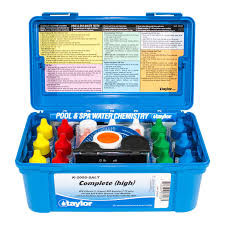Product Description
The Comprehensive Guide to Using a 6-Way Test Kit for Free Chlorine, Total Chlorine, Bromine, and pH Levels in Your Hot Tub
Swimming in a hot tub that has perfectly balanced water is an experience beyond comparison. However, maintaining this balance necessitates consistent testing and tweaking of your hot tub's water chemistry. This article will guide you through the process of using a 6-way test kit to measure free chlorine, total chlorine, bromine, and pH levels in your hot tub.
Introduction to Hot Tubs
The hot tub, a symbol of relaxation and leisure, is a staple in many homes. However, maintaining the water quality in a hot tub requires consistent effort. A hot tub's water chemistry can quickly become unbalanced due to various factors such as the number of users, the frequency of use, and environmental conditions.
Importance of Water Testing in Hot Tubs
The importance of regular water testing in hot tubs cannot be overstated. A hot tub filled with unbalanced water can lead to several issues, including skin and eye irritation, ineffective sanitization, and possible damage to the hot tub's internal components. Regular testing helps ensure that the water is safe for users and that the hot tub operates efficiently.
Understanding the Water Tests Required for a Hot Tub
There are several parameters to consider when testing the water in your hot tub. You should regularly test for:
- pH Levels: The pH level measures the acidity or basicity of your hot tub's water. An ideal pH level falls between 7.4 and 7.6.
- Total Alkalinity: This measures the water's ability to neutralize acids. The ideal range is between 80 and 120 parts per million (ppm).
- Calcium Hardness: This measures the amount of calcium in the water. The ideal range is between 200 and 400 ppm.
- Free and Total Chlorine: These measure the amount of active and total sanitizer in the water. The ideal range for free chlorine is between 2.0 and 4.0 ppm.
- Bromine: This is an alternative to chlorine and should be between 3.0 and 5.0 ppm.
- Cyanuric Acid: This protects chlorine from being broken down by sunlight. The ideal range is between 30 and 50 ppm.
Frequency of Water Testing
The frequency of water testing can vary depending on usage and environmental conditions. However, as a general rule, you should test your hot tub water at least once a week.
How to Test Hot Tub Water
Testing your hot tub water is a straightforward process.
- Collect a water sample from your hot tub, about 12 to 18 inches below the water surface.
- Follow the instructions on your chosen test kit.
- Record your results and adjust your hot tub's chemical levels as necessary.
Types of Hot Tub Water Tests
When it comes to testing your hot tub water, you have several options:
- Test Strips: These are the most affordable and widely used. They provide instant results but may not be as accurate as other methods.
- Liquid Test Kits: These kits use reagents that are added to a water sample. They are more accurate than test strips but require more effort to use.
- Digital Testers: These testers provide the most accurate results and are the easiest to use. However, they are also the most expensive.
Which Hot Tub Water Test Should You Choose?
Your choice of hot tub water test will depend on your budget and how accurate you want your results to be. For regular maintenance checks, test strips are a cost-effective and convenient choice. For more accurate results, a liquid test kit or digital tester may be more suitable.
How to Use a 6-Way Test Kit
A 6-way test kit allows you to test multiple chemical levels at once. Here's how to use one:
- Fill the test kit's container with water from your hot tub.
- Add the recommended number of drops of each reagent to the water sample, based on the kit's instructions.
- Compare the color of the water sample to the color chart provided with the kit to determine the levels of each chemical.
Understanding Your Test Results
Once you've completed your test, you'll need to interpret your results. If the chemical levels are within the recommended ranges, your hot tub water is well-balanced. If not, you'll need to adjust the levels accordingly.
Adjusting Your Hot Tub's Chemical Levels
If your test results indicate that your hot tub's water chemistry is off-balance, you'll need to adjust the levels of the relevant chemicals. This can be done by adding specific products to your hot tub water, such as pH increasers or decreasers, chlorine or bromine, and calcium hardness increasers.
Professional Water Testing
If you're unsure about testing your hot tub's water yourself, you can also opt for professional water testing. Many pool and hot tub stores offer this service, and some even do it for free.
Conclusion
Maintaining the water quality in your hot tub might seem daunting at first, but with the right tools and a bit of practice, it becomes a straightforward process. Regular testing and adjustment of your hot tub's water chemistry will ensure a safe and enjoyable experience for all users.
Remember, if you need any parts for your hot tub, Western Tub and Pool can provide them. You can reach them at 1-855-248-0777. Keep your hot tub safe, clean, and well-maintained for a relaxing dip anytime!
 Canadian Dollars
Canadian Dollars
 US Dollar
US Dollar
 Euro
Euro








